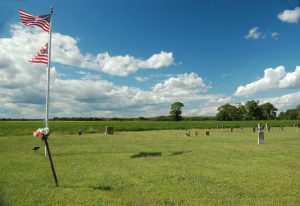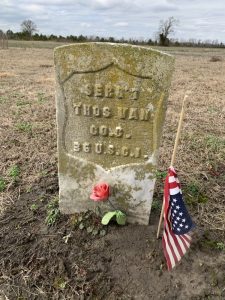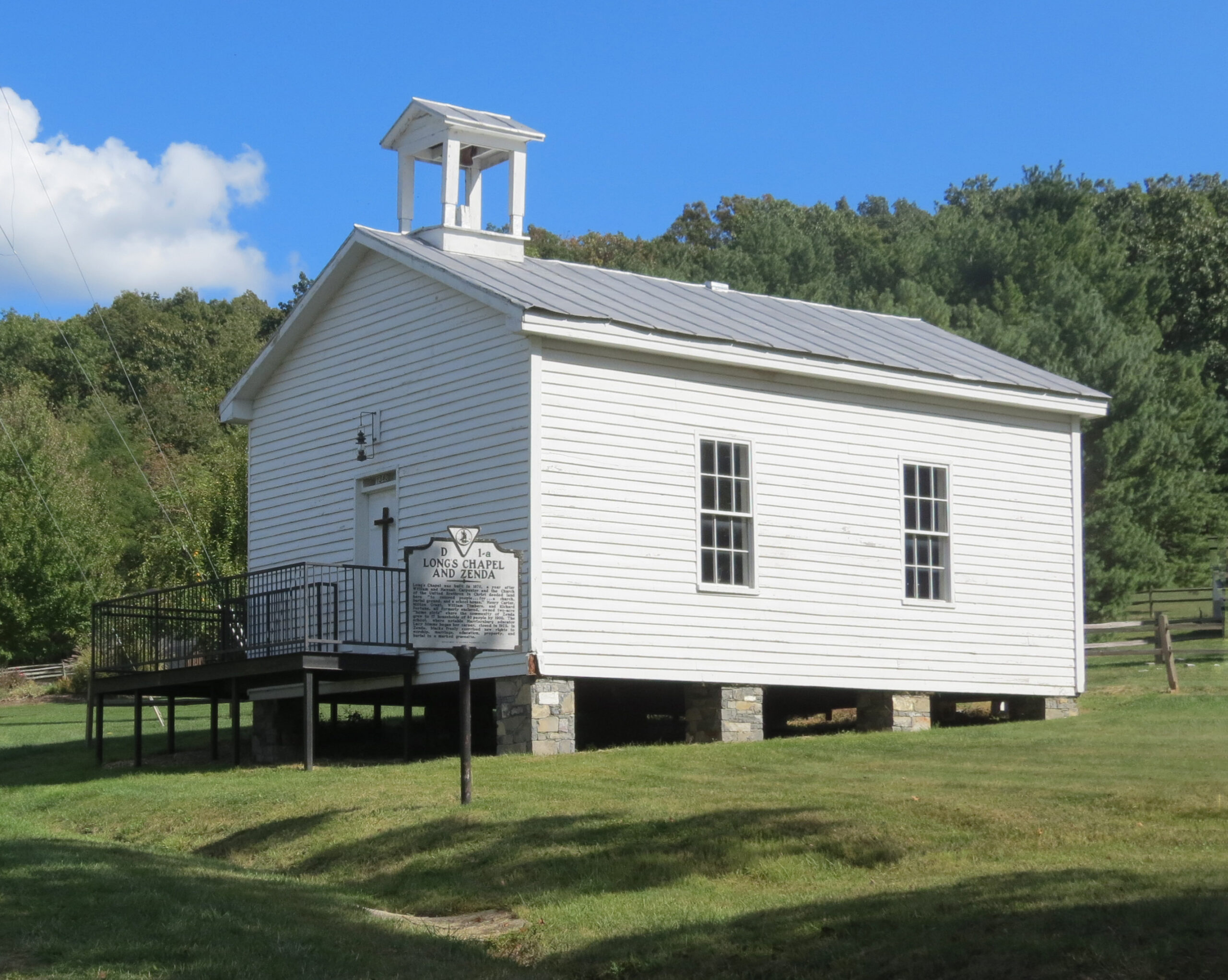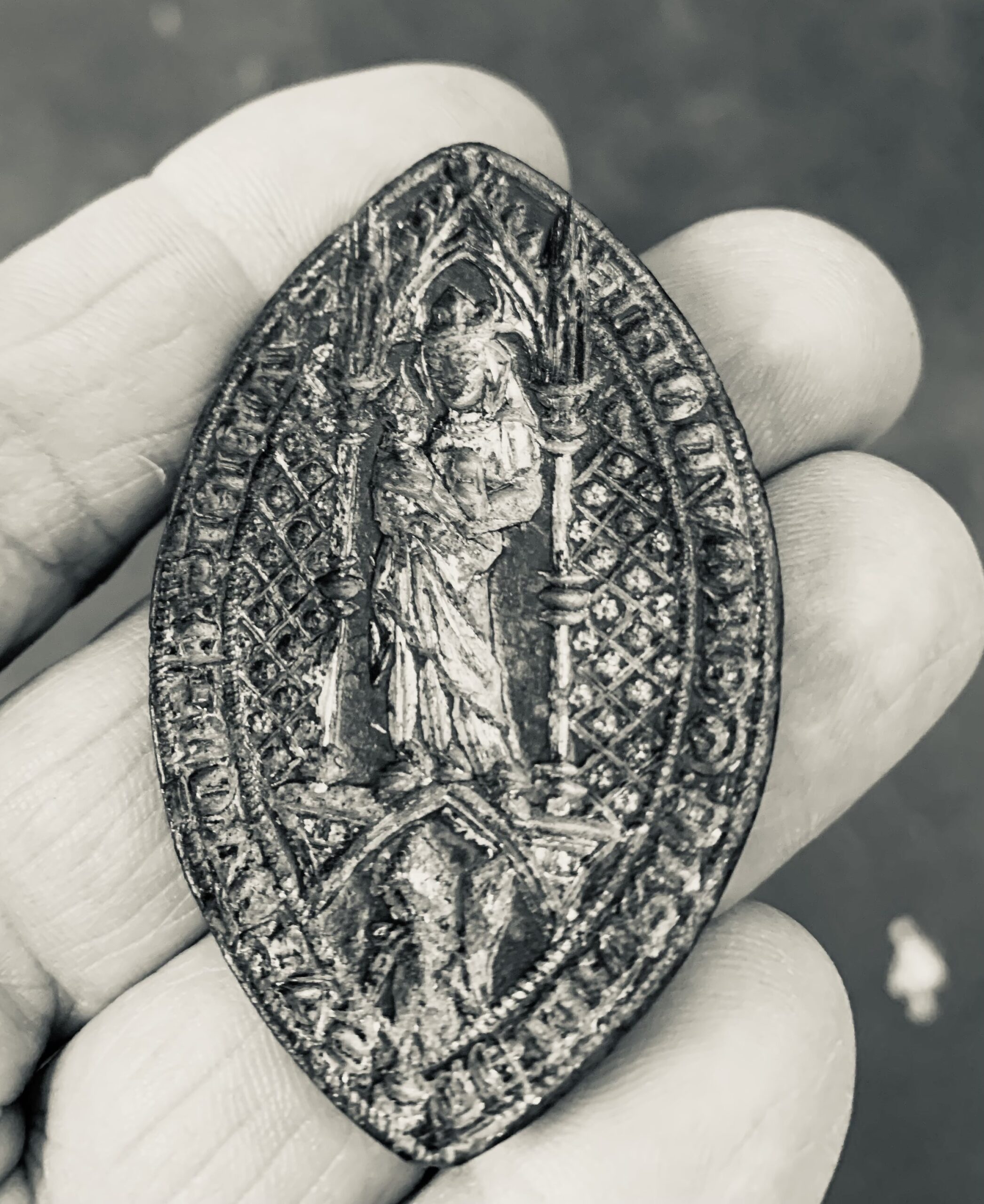13 USCT Soldiers, Cuffeytown Cemetery, City of Chesapeake
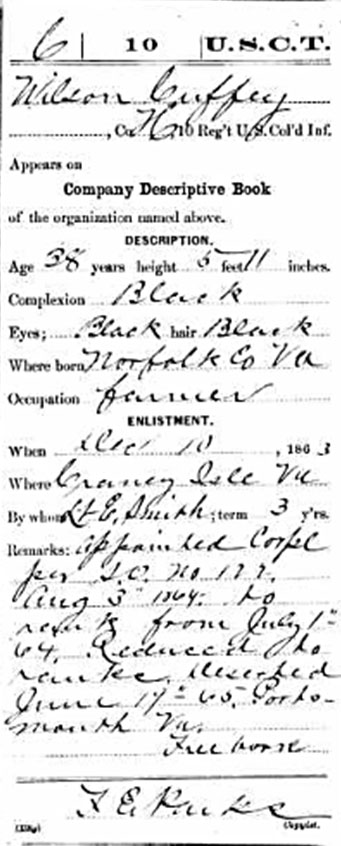
In January of 2020, DHR archaeologist Mike Clem traveled to Cuffeytown Cemetery, in Chesapeake, to document the number of burials dating prior to 1900, as well as those of people born before 1900 but who died in the 20th century. He did so to support the caretakers of the cemetery, who were applying for funds from the Commonwealth for the upkeep of the grounds. Certain thresholds must be met to receive such support from the African American Cemetery and Graves Fund. (Visit this webpage to learn more about the fund.) Here's Mike's report:
The cemetery is not easy to find.
Cuffeytown is a small community about nine miles from the North Carolina border. After a few passes, I eventually saw a distant flagpole way out in the field. Entering what seemed to be the only access point, I parked and made the long walk across soggy agricultural fields.The markers in the cemetery include a number of handmade stone and concrete memorials with unique decorations carved into them. There are also some less conventional markers such as pipes in the ground or just a simple fieldstone.
Most striking of all were the 13 markers dedicated to U.S. Colored Troops buried there. This is the largest number of USCT graves in any cemetery in Virginia. They mark the resting place of men who had been relatives, friends, and neighbors. Most of these men were free men of color and always had been. According to several sources, Cuffeytown was established as a free community in the late-18th century and remained so. Indeed, the enlistment records for many of the men list them as “free born.”
Following my visit to the cemetery, I searched to find what documents I could about these soldiers (and found the richest trove of documents on Ancestry.com). The records are spotty but I was able to find a little something online for each of them. These veterans seem to have generally stayed close to home following the Civil War, returning as well to their old livelihoods. Most were listed in the Federal Census as farmers or laborers before the war and similarly listed in census records after the war.
The 1870 federal census shows many of the men still living within the community. Scrolling through the records is almost like walking Butts or Cuffee Roads in what was then Norfolk County. One house of Cuffeys is followed by another (spelled Cuffee), and then a Whitehurst or a Smith house. Between what small details these official records tell us of these 13 men, we can only wonder at the lives they lived and their bravery.
Here are the men that served:
- 5TH USCT: Private Walter Smith, Company I
- 10TH USCT: Sergeant William Cuffey, Company G; Private Bluet Cuffey, Company H; Corporal Emerson Cuffey, Company G; Private Lemuel Cuffey, Company F; Sergeant Wilson Cuffey, Company H; Sergeant William Cuffey, Company F; Corporal Levi Sevils, Company H; Private Cornelius Smith, Company F; Private James W. Smith, Company F; Private Samuel Smith, Company H; Private John Whitehurst, Company H.
- 36TH USCT: Sergeant Thomas Van, Company C.
A brief summary of the actions of the regiments to which the men belonged gives a glimpse of what they endured.
36th USCT
The 36th U.S. Colored Infantry was organized in February 1864 from the 2nd North Carolina Colored Infantry under the command of Colonel Alonzo G. Draper. The 36th was initially given guard duty at Point Lookout in Maryland but was moved to Bermuda Hundred along the James River and took part in siege operations against Petersburg and Richmond from July 1864 until April of 1865. They also took part in the engagements in Virginia at Chaffin's Farm, New Market Heights, the Battle of Fair Oaks, Dutch Gap, Indiantown, and in North Carolina at Sandy Creek.
The 36th also had a part in the Appomattox Campaign and the subsequent occupation of Richmond. Eventually they were moved to Texas for duty along the Rio Grande and at various other points within Texas until being mustered out in October 1866. The regiment lost a total of 224 men during service; 8 officers and 79 enlisted men killed or mortally wounded, 5 officers and 132 enlisted men died of disease.
10th USCT
The 10th U.S. Colored Infantry was organized at Camp Craney Island, Virginia, in November of 1863. Command was assigned to Colonel Spencer H. Stafford. They were first moved to Drummondtown (now known as Accomac), on the Eastern Shore of Virginia, and served there until April 1864. The 10th then assisted with Maj. Gen. Benjamin F. Butler's operations south of the James River and against Petersburg and Richmond from May 4 to June 15. The 10th took part in the capture of Fort Powhatan and the action at Wilson's Wharf in May. They were stationed at Fort Powhatan until July. The 10th was then on the Bermuda Hundred front in operations against Petersburg and Richmond until August. They were then at City Point (Hopewell), Va., until April 1865, when they were moved to Bermuda Hundred and then to Richmond. Finally, they were stationed in Texas and had duty at various points on the Rio Grande until May 1866.
A detachment of the 10th served from November, 1863 to April, 1864, at Plymouth, North Carolina, and participated in the siege and its surrender on April 20, 1864. Lemuel Cuffey may have suffered a serious injury during his service. Records show several transfers to various military hospitals before he is discharged from a hospital in New Jersey in 1864. He goes on to collect pension income for decades.
Lemuel Cuffey's life glimpsed in official documents:
5th USCI
The 5th United States Colored Infantry Regiment was formed as the 127th Ohio Infantry Regiment at Camp Delaware, Ohio. It was re-designated and moved to Norfolk in November 1863. It served at Norfolk and Portsmouth in the Department of Virginia and North Carolina until January 1864, during which time the unit participated in Brigadier General Edward A. Wild's expedition into North Carolina. The 5th was then moved to Yorktown, where it became part of the XVIII Corps. The regiment was involved in Union Brigadier General Isaac J. Wistar's expedition against Richmond in February 1864, and in March, an expedition to New Kent Court House in aid of Brigadier General Hugh Judson Kilpatrick's cavalry, an expedition into King and Queen County, and an expedition into Mathews and Middlesex Counties.
The 5th regiment participated in the capture of City Point (Hopewell) in May of 1864, and while in the city the regiment served fatigue duty and built Fort Converse on the Appomattox River. The 5th defended an attack against Fort Converse on May 20, and took part in General Butler's operations south of the James River and against Petersburg and Richmond. The unit participated in action at Bailor's Farm in June of 1864, before taking part in the Richmond–Petersburg Campaign from June to December, 1864. The regiment served in the trenches around Petersburg, seeing action there during the Battle of the Crater on July 30.
On August 28, 1864, the 5th regiment moved to Deep Bottom in Henrico County, and subsequently participated in the Battle of Chaffin's Farm and Fort Harrison and the Battle of Fair Oaks before returning to the trenches, this time near Richmond. Four men of the regiment received the Medal of Honor for their actions at Chaffin's Farm.
In December the unit was assigned to the newly formed XXV Corps and took part in multiple battles over the next months throughout North Carolina. In March 1865, the regiment was reassigned to the X Corps and took part in General William Tecumseh Sherman's Carolinas Campaign. With the end of the war at hand, the men of the 5th witnessed the surrender of Confederate General Joseph E. Johnston and his army on April 26, 1865. The unit served out the rest of its term in North Carolina and the 5th United States Colored Infantry was mustered out on September 20, 1865, after two years of existence.
The regiment lost a total of 249 men during its service; four officers and 77 enlisted men were killed or mortally wounded and two officers and 166 enlisted men died of disease.
Markers and historical documents:
–Mike Clem
Eastern Region Archaeologist, DHR
